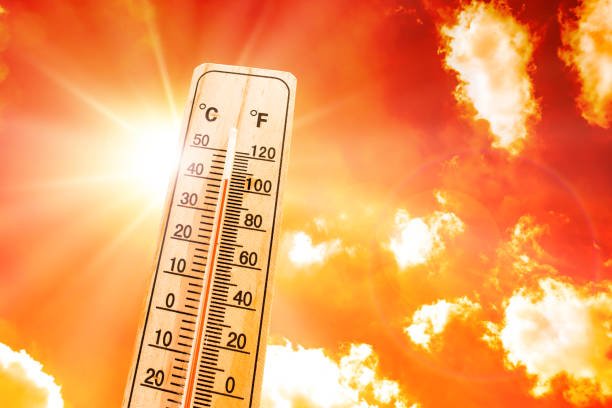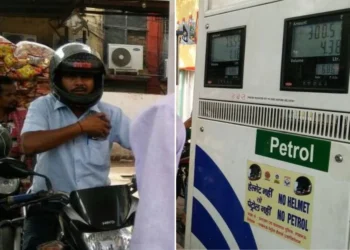heat wave in India
2025 has been recorded as one of the hottest years in recent history, with India experiencing record-breaking temperatures. This intense heat wave began in early April, disrupting normal climate patterns across the country. Where the month of April was once considered a pleasant one, today many states have reported temperatures exceeding 45°C in early April itself, making this summer one of the most extreme summers in over a decade.
As a result, this exceptional heat wave affected the Indian monsoon in 2025 entirely. While monsoon is usually expected to arrive between June and early July, it has been delayed in many regions of India this year. As of late July, several northern and central Indian states have still not received significant rainfall. This is raising concerns about drought, crop failure, and water shortages.
This alarming pattern of rising temperatures and changing rainfall underlines the urgent need for climate adaptation and better heatwave preparedness across India.
Indian States That Hit Boiling Point This Summer
Mapping from the top most part of India, Rajasthan’s Barmer recorded a blistering high of 45.6 °C and Jaisalmer peaked at 45.0 °C in the month of early April. Similarly, in the month of June in some parts of Rajasthan, especially northern parts like Sri Ganganagar recorded peaks of 48.0 °C on June 12.
Haryana’s Sirsa faced temperatures around 47.4 °C, and Delhi NCR regions also recorded high heatwaves above 45 °C, with minimum temperatures rarely dropping below 30 °C.
Punjab’s Bathinda reached up to 46.8 °C meanwhile the states of Madhya Pradesh, East Uttar Pradesh, and parts of Chhattisgarh and Odisha had also sustained heatwave conditions with scorching heat ranging from 43 °C to 46 °C.
Some regions like West Uttar Pradesh, Chandigarh, and parts of remaining Gujarat and Bihar and Jharkhand border regions regularly saw daily threshold of 40 to 42 °C.
States like Jharkhand, Chhattisgarh, and Odisha registered moderate heatwave events with temperatures around 41 °C to 43 °C, but facing high humidity.
While the states of South India are considered to have moderate climate and experience less heat, this year IMD’s seasonal forecast warned of higher-than-usual heatwave days in peninsular India. The interior regions like Telangana, Rayalaseema, north Karnataka recorded temperatures nearing 42 to 44°C, which is unusual for early April in the states of South India.
While the impact of heat waves in South India is not as intense as North India, it is still concerning.
Scorched Earth, Dry Skies
Due to the disruption in the climatic condition because of the intense heat, the sky forgets its rhythm, the monsoon drifts in slowly, and the rains come in sighs, not showers.
Yes, the intense heat wave has entirely changed the climatic condition in the year of 2025. Where the monsoon used to arrive by the end of June and start of early July it’s still stuck somewhere in the sky.
- Where states like Bihar is expected to receive a rainfall early in the month of July, and nearly ~263.2 mm it just received as less as an amount of ~130.9 mm that accounts in a 50 % deficit.
This has impacted the paddy sowing by getting delayed, reservoirs remained empty, farmers faced drought risk.
- Andhra Pradesh’s Rayalaseema receives a rainfall of ~4.0 mm but it also faced a deficit of 82%.
Later through early July, the entire region lagged with an overall rainfall deficit ~38–46%.
- The eastern parts of Uttar Pradesh tends to receive a rainfall of ~8.3 mm in early July but it has also been seen with 26% shortfall in July 2025
High heat suppressed monsoon activity.
- Marathwada in Maharashtra receives an annual rainfall of 78% but only ~0.52 cm received when substantial monsoon rains are critical.
- Telangana and Andhra Pradesh saw more rain overall but still significantly below average in certain districts, affecting sowing and water storage.
Human death tolls and health impacts
The unparalleled heat of 2025 has snatched the soul out of the human body and left the body to melt in this record breaking summer of 2025.
In 2025, official statistics from the 2025 India–Pakistan heat wave note 195 heat-related deaths in April and around 260 deaths in May, often linked to heat and related weather events.
Even the hospitals saw a 20% increase in heat-related ailments: dehydration, nausea, vomiting, dysentery, headaches, and kidney or liver in cities like Patna.
The communities that were more at the risk of getting trapped in the intense heat wave were elderly, children, pregnant women, daily wage laborers, and those with chronic conditions.
And not just the life of human beings has been taken away by these heat strokes but the life of innocent and speechless animals were equally affected.
In Ahmedabad, between April 1 and May 18, the Jivdaya Charitable Trust treated 8,939 animals and birds for heat-related trauma including 5,125 mammals and 3,814 birds like pigeons, black kites, doves, hornbills, and endangered species.
Symptoms majorly included dehydration, disorientation, and collapse.
In New Delhi, Wildlife SOS and rescue teams collected around 150 birds in a single week at the Wazirabad centre out of which many suffered from heatstroke and dehydration. The species affected include barbet, black kite, barn owl, hornbill, fruit bat, and snakes.
And not just the preserved animals but also the wandering street dogs collapsed or died from heatstroke despite volunteer efforts to provide water.
Similarly in Kerala in the districts of Kollam and Palakkad, about 500 cattle died within two-and-a-half months due to extreme heat exposure. Many crossbred cows collapsed, refusing water and fodder.
Nizam, a dairy farmer says, “I have been rearing cows for over 30 years, but I am seeing heatstroke deaths for the first time,” after one of his cows delivered a calf on April 6, it began to slobber and breathe laboriously. He further said, “Despite hydration efforts and applying water several times a day, the cow collapsed and died. The cow had cost me ₹75,000 and it was producing around 20 litres of milk a day. I have 14 more cows and I can see them struggling to tolerate thermal stress.”
Who is suffering the most?
The answer is the most vulnerable group of society that is the poor people, who are suffering the most. They neither have a pacca house nor a cold shelter to hide themselves from excessive and intense heat. Those inside a well-built, brick walled house lying under a cooler or AC might not know the disastrous condition of the outer world due that the intense heat is causing it with each passing day.
Among the worst affected were daily wage laborers, farmers, street vendors, and slum dwellers communities exposed to relentless heat with little to no access to shelter or cooling. Women and the elderly bore a compounded burden, facing acute water shortages and prolonged outdoor exposure.
Huge impact on agriculture and economy
Not only human beings and animals are affected but also agriculture is affected on a large scale and due to it the economy of the country is also affected. So basically the intense heat wave in 2025 has caused a shake in the economy of the country.
First of all the delayed monsoon and extreme heat reduced crop yield, especially paddy, cotton, and pulses.
Secondly, the dairy & livestock hit: The milk production fell as hundreds of cattle died, especially in Kerala and Maharashtra.
Thirdly the labour productivity dropped: Outdoor workers couldn’t work full days; income loss in informal sectors.
At last but not the least, power demand hyped suddenly and high electricity use caused blackouts and stressed grids.
Also the healthcare burden increased: Hospitals saw spikes in dehydration, heatstroke, and respiratory issues.
Is this anyone’s fault?
Failures in Policy and Planning
According to a comprehensive compilation as of mid‑2025, many Indian states like Andhra Pradesh, Bihar, Delhi, Goa, Gujarat, Haryana, Himachal Pradesh, Karnataka, Kerala, Odisha, Rajasthan, Tamil Nadu, Telangana, Uttar Pradesh, West Bengal, and Jammu & Kashmir have adopted heat action plans.
But they lack proper implementation.
What is HAP?
HAPs guide early warning systems, public outreach, cooling interventions, hydration points, and standard treatment protocols.
The government needs to take initiatives in order to control the increasing heat each year.
Initiatives like
- Strengthen and Expand Heat Action Plans (HAPs)
- Ensure Water Security in different regions of county
- Build Climate-Resilient Health Infrastructure
- Protect Workers & Livelihoods by providing them with proper heat resistant clothes
- Green Cities & Rural Areas by ensuring the tree plantation as much as possible
- Expand Access to Cooling by helping poor ones build their pacca roofs
- Improve Data and Monitoring
- Awareness and Education
- Policy and Climate Integration
- Collaborate & Fund
Our responsibility
In order to step towards a cooler future we all need to come forward to working on ourselves and our environment by keeping a keen eye on what’s happening around us and what could be its impact on us and on our future generations.
We may help the government by addressing the problem and dealing with it from our perspective as well. We may ensure to reduce the emission of CFCs wherever possible because the emission of CFCs is one of the biggest reasons of global warming and this increasing heat. Increasing awareness amongst people around us and teaching those who are younger than us will ensure a healthier and cooler future ahead, as it once used to be.








